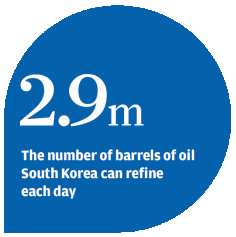
Melting Arctic ice paves the way for South Korean oil hub
Country eyes role as storage centre in regionas melting Arctic ice opens up trading route from Europe to Asia
Melting Arctic ice is widening a path for ships to deliver European oil to Asia, stoking South Korea's ambition to become a regional storage and trading hub.

Deputy Energy and Resources Minister Kim Jun-dong said the country was also seeking to leverage its energy infrastructure, which includes five refineries, to become northeast Asia's oil hub.
Global temperatures are rising, breaking up polar ice and opening the Northern Sea Route to tanker traffic for a longer period each year than the four months from July to October. It is forecast to be ice-free for six months by 2020, boosting Korea's appeal as the destination for European cargoes that traders could potentially ship again to other Asian countries.
"We've noticed a huge difference in trading routes," said Erik Hanell, the chief executive of Stena Bulk in Gothenburg, Sweden, which controls a fleet of 110 tankers. "China is importing more and all the countries in the Far East are importing a lot more.
The Northern Sea Route would cut journeys considerably for energy shipments
"South Korea has a very strong geographic position in today's development of both Arctic oil and China's growing demand."
Resource-scarce Korea, Asia's fourth-largest economy, depends on exports for more than half of its gross domestic product. It is seeking to lure energy traders, having designated 12 oil-storage facilities as free-trade zones.
The nation's global trade climbed to US$1 trillion last year, customs data shows, and President Park Geun-hye is seeking to boost annual growth by a percentage point to 4 per cent.
"After the oil hub is established, we expect to make more than US$25 billion annually" in storing and processing cargoes for third parties, Kim said.
The country's free-trade agreement with the European Union waives a 3 per cent tariff on imports, which is drawing shipments from the North Sea.
Stena Bulk, whose line-up includes 15 "ice class" vessels capable of sailing through the Arctic, teamed up with Korea's Hyundai Glovis to transport 44,000 tonnes of naphtha from Ust Luga, near Saint Petersburg, to Yeosu last year, Hanell said. That is about 396,000 barrels.
The voyage by the Stena Polaris was covered in 35 days, compared with a typical seven-week journey through the Suez Canal.
Korea was the destination last year for at least three ships travelling through the Northern Sea Route, while six made the voyage in 2012, according to consultant IHS Maritime. The tankers carried naphtha and ultra-light crude known as condensate.
"The Northern Sea Route would cut journeys considerably for energy shipments heading from Europe and Russia to northeast Asian markets, even after factoring slow steaming due to ice," said Gary Li, a senior analyst at IHS Maritime in Beijing.
The world experienced its warmest May in more than a century this year, data from the United States National Oceanic and Atmospheric Administration shows. The earth's combined land and sea temperature for May was 15.5 degrees Celsius, a record 0.74 degree warmer than the 20th century average, it said last month.
As global temperatures rise, the Northern Sea Route, which follows Russia's Siberian coast, will be completely free of ice all-year round by 2030, according to the Korean government's Korea Energy Economics Institute.
It is the shortest shipping lane connecting Europe to Asia.
The waters off Siberia first became sufficiently ice-free in the summer of 2005 for voyages to be considered, with satellites suggesting in 2008 that the route might be passable.
Korea, which has about 2.9 million barrels a day of refining capacity compared with Singapore's 1.4 million, was "most favourably located" to benefit, Kim said.
Still, tanks alone may not be enough for Korea to stake a claim as Asia's oil-trading centre. The "key challenge" would be to sell its surplus products into other Asian markets, said Sushant Gupta, the head of Asia-Pacific downstream research at consultant Wood Mackenzie.
Even as Korea's capacity swelled, Malaysia and Singapore were adding facilities that would maintain Southeast Asia's appeal, Gupta said.
Singapore currently offers almost 63 million barrels of storage capacity, and is also home to Royal Dutch Shell's biggest refinery as well as chemical and oil plants operated by ExxonMobil.
Last month, Malaysian Prime Minister Najib Razak opened the first phase of a storage complex partly owned by Royal Vopak, the world's largest independent tank operator, in Johor state.
